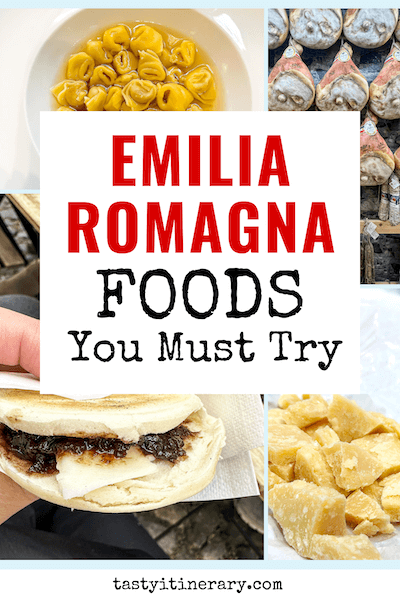
What is the food of Emilia-Romagna? What makes this region the foodie capital of Italy?
Where is Emilia-Romagna? Emilia-Romagna is a region in northern Italy located between Tuscany, Lombardy, and Veneto. It is home to some of the most renowned cities in Italy, such as Bologna, Parma, Modena, and Ravenna.
What is Emilia-Romagna famous for?
The food!
And you’re probably thinking, isn’t food in Italy half the reason we travel there? Isn’t it amazing everywhere you go?
Yes, the food in Italy is incredible. Eating the food in Italy is one of the best experiences and one of the many reasons to visit.
Many of the Italy foods we love to eat and have become a part of our culture originated in Emilia-Romagna. This region has some of the most famous Italian dishes and ingredients.
This region of Italy is known for its fresh ingredients, homemade pasta, and rich flavors. It’s also known as Italy’s culinary capital and Italy’s food valley.
Food lovers can explore the variety of dishes from the different cities of this region and learn about their traditional cooking methods and recipes.
While every city has unique culinary traditions, there are a few local delicacies all Emilia-Romagna foods should sample. While you can get some of these ingredients and dishes outside Emilia-Romagna, it’s not the same.
Believe us. It’s not the same as being there and eating the Emilia-Romagna cuisine.
After reading and hearing so much about the food in Bologna and other cities of Emilia-Romagna, we were pressed to make a trip there. We fit it into our most recent Italy trip and visited the top three cities Bologna, Parma, and Modena. Not sure what took us so long to get there.

This post may contain affiliate links, which means we’ll receive a commission if you purchase through our links, at no extra cost to you. Please read full disclosure for more information. We appreciate your support!
We found that the locals in these cities took their food seriously and served us some of the best food we had in Italy.
The passion behind the food and ingredients was evident in every dish we sampled. We had an abundance of fresh homemade pasta dishes, cured meats, and local cheeses of various ages.
In this article, we dive into the most popular Emilia-Romagna foods and where they originate from. So when you plan your trip to the Emilia-Romagna region, you can have an exciting and delicious tasty itinerary. However, having a bad experience while eating throughout the region would be difficult.
From the world-famous Bolognese sauce to Parmigiano Reggiano cheese, the food of Emilia-Romagna is some of the most beloved in Italy.
Emilia-Romagna Foods
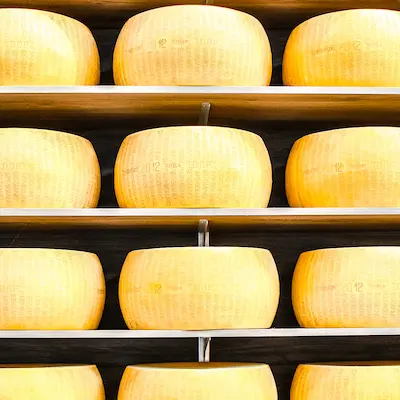
What are 3 food specialties of Bologna?
Bologna’s three top food specialties are Tagliatelle al Ragu, Tortellini in Brodo, and Mortadella.
What are foods grown in Emilia-Romagna?
What does Emilia-Romagna produce?
Emilia-Romagna is also known for producing a variety of cured meats, such as salami, prosciutto, and culatello. It is also home to the world-famous Parmigiano Reggiano cheese, considered the world’s best Parmesan.
What food is Emilia-Romagna famous for?
We all know and love a few Emilia-Romagna foods, such as Parmigiano Reggiano cheese, Prosciutto di Parma, Aceto Balsamico di Modena, and Ragú (bolognese sauce). These are all staples of Italian cuisine that have become popular worldwide.
Food of Emilia-Romagna
The food culture of Emilia-Romagna is deep-rooted and has evolved over the centuries. Food has always been an important part of Emilia-Romagna’s culture, with dishes passed down from generation to generation.
Here are the Emilia-Romagna foods and dishes you should try.
1. Tortellini

Tortellini is a stuffed pasta supposedly shaped like the goddess Venus’s Navel. It does resemble a belly button.
This handmade pasta is usually stuffed with pork, mortadella, and Parmigiano Reggiano cheese. It is served in a broth or with tomato sauce.
Bologna and Modena both lay claim to the invention of tortellini. We’ve had tortellini in both cities and were blown away by the flavors, sizes, and variety.
During a food tour in Bologna, we visited a small pasta factory where several Italian women gather daily to prepare thousands of tortellini by hand.
Tour Ideas:
Bologna Food Tour from a Local Perspective [book here]
2. Tagliatelle al Ragù
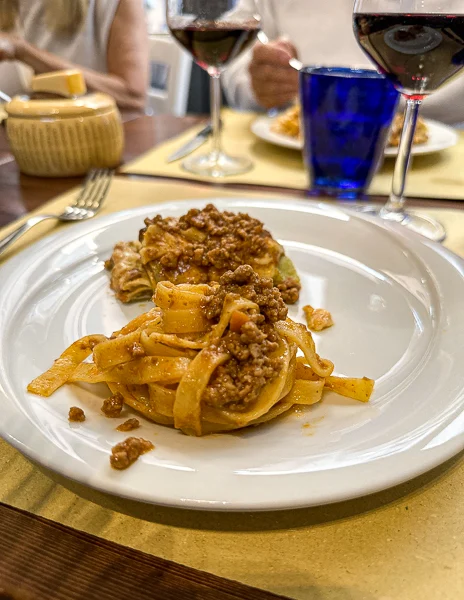
We’ve all heard of and have probably eaten spaghetti bolognese. Only that the version we are familiar with is a very distant third or fourth cousin of Bologna’s Tagliatelle al ragù.
Tagliatelle al ragù is a classic bolognese dish you’ll find throughout Emilia Romagna, especially in Bologna, where it originates from.
The Tagliatelle pasta is a flat, long pasta somewhat similar to fettuccine. It is served in a slow-cooked ragu (a rich sauce) made with ground meat and tomatoes. Every restaurant will have its own recipe and claim to have the best ragù.
If you want to visit Bologna and order ragù everywhere, you can. You will probably have a hard time deciding which one is the best.
You can also try to make the Emilia Romagna cuisine at home if you can’t make it to Bologna anytime soon: La Cucina Italiana’s Traditional Tagliatelle a Ragù Recipe.
3. Parmigiano Reggiano

Parmigiano Reggiano DOP is produced exclusively in Emilia Romagna in Parma, Reggio Emilia, and small parts of Modena and Bologna. The majority is produced in Parma, where it originates from.
This cow’s milk cheese has a long ripening process of at least 12 months. The flavor is nutty and salty, and the texture is crumbly. The taste and texture change and evolves as the cheese matures. You can get Parmigiano Reggiano DOP from 12 months, 24 months, 36 months, and more. The longer the cheese ages, the nuttier the flavor becomes and the harder the texture becomes.
The DOP stands for Protected Designation of Origin and means that Parmigiano Reggiano must comply with strict regulations to carry the name.
So when you’re looking for Parmigiano Reggiano, if it’s labeled D.O.P., you know it passed all the strict qualifications.
It’s said that the 24-month Parmigiano Reggiano is the best for grating on pasta.
Tour Ideas:
Private Half Day Parma Food Walking Tour [book here]
Parmigiano Reggiano Cheese Tasting Tour [book here]
4. Aceto Balsamico Tradizionale DOP

Another food of Emilia-Romagna that is a Protected Designation of Origin from Emilia-Romagna is Aceto Balsamico Tradizionale DOP.
You’ve heard of and had balsamic vinegar before and probably have it when you eat a salad. However, the one from Emilia-Romagna is nothing like the one you buy at home.
The real stuff is made in Modena, and Reggio Emilia from various local grapes is cooked down to concentrate the flavors. The must (the cooked-down grape juice) is aged 12-100 years in different wooden casks, giving it a unique flavor. The flavor becomes more complex and intense as it ages.
The older the vinegar, the thicker it is.
The cost of Aceto Balsamico Tradizionale DOP depends on the age of the product. The longer it’s aged, the more expensive it gets.
We highly suggest doing a balsamic vinegar tasting tour in Modena or the Emilia-Romagna region. You’ll better understand the different ages and levels of flavor based on the grapes used for the vinegar and the type of wooden barrels. No balsamic vinegar is the same as another. You will also favor one over the other and bring a bottle home.
While in Modena, we learned locals like to save the more expensive DOP bottles for special occasions. You can buy amazing bottles of balsamic vinegar that are not DOP, taste just as amazing, and are for daily use.
Also, different ages are used for different dishes. Like Aceto Balsamico Tradizionale DOP. You it over gelato, pasta, or meats as a finishing touch.
A little goes a long way. It’s liquid gold.
For cooking and salads, you’ll want to use Balsamic Vinegar of Modena IGP, balsamic vinegar aged up to 30 days to 3 years.
Tour Ideas:
Tour Oldest Balsamic Vinegar Company in Modena [book here]
Discovering the Balsamic Vinegar of Modena [book here]
5. Prosciutto di Parma
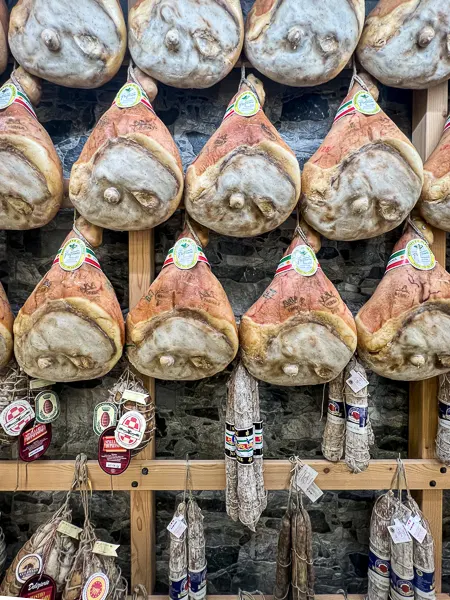
The Prosciutto di Parma is a beloved staple of Italy and one of the Emilia Romagna foods from this region. The Prosciutto di Parma DOP is produced in Parma, one of Italy’s most famous salumi products. There is no antipasto without prosciutto.
Prosciutto di Parma is the pig’s high legs that are air-dried, salted, and cured for aged 12 to 24 months. This aging process gives it an intense flavor, and the texture is tender yet firm and moist.
The DOP guarantees the prosciutto is made from certain pork breeds, raised within the province of Parma, and follows a certain production process.
Prosciutto di Parma is the pig’s high legs that are air-dried, salted, and cured for aged 12 to 24 months. This aging process gives it an intense flavor, and the texture is tender yet firm and moist.
This salumi product is produced all over Italy, but only the one from Parma can be labeled DOP.

From our experience, the taste and texture differed from the prosciutto we ate in Emilia Romagna to the one we ate in Tuscany. Both were delicious, but the prosciutto we ate in Parma was more tender.
Tour Ideas:
Parmigiano cheese and Parma Ham Tour [book here]
11 Tantalizing Florence Foods to Eat
What are the foods in Florence, Italy you should be eating? Add these Florence foods to your foodie bucket list. Italian cuisine is one of the most popular and loved in the world. When you visit Italy, you discover that Italian food varies from region to region and even city to city. | tastyitinerary.com
6. Gnocco Fritto

Gnocco fritto is one of our favorite Emilia-Romagna foods. It’s a fried pillowy dough that’s light, fluffy, and crispy. It’s usually served as an appetizer with salumi and cheese or enjoyed independently. And locals typically like to eat this with a glass of their local sparkling wine, Lambrusco.
Every city in Emilia-Romagna will call it something different. In Bologna, it’s crescentina. In Parma, it’s torta fritta. In Ferrara, it’s pinzino.

In Modena, we also tried gnocco fritto for breakfast, dipping it in a cappuccino. It was a lovely combination.
7. Tigelle
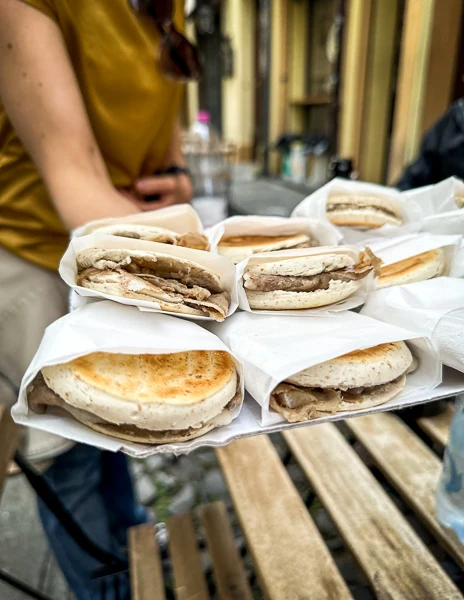
Another popular food of Emilia-Romagna is the Tigelle. It’s a small, circular flatbread made from wheat flour, yeast, extra-virgin olive oil, and salt. The dough is pressed from terracotta tiles specifically for making tigelle.
Tigelle is usually served warm, cut in half, and filled with various salumi like mortadella, prosciutto, and Formaggio. Sometimes local pestos and other sweet spreads company the tigelle.

It’s considered one of the oldest recipes in Emilia-Romagna, and each town has its variation. You’ll see tigelle on dinner menus, but it’s also a popular street food.
8. Culatello di Zibello

We had never heard of or eaten Culatello di Zibello until we were in Emilia-Romagna. This salumi product is an exclusive food of the Emilia-Romagna region.
Culatello di Zibello DOP is similar to prosciutto di Parma, only is the deboned thigh muscles of the pig. The curing process is in a small village called Zibello in the province of Parma, where the humidity is perfect for aging the culatello.
The taste of Culatello di Zibello is more intense than prosciutto di Parma. It’s delicate, soft, and delicious. We tried it at the salumeria and had them vacuum pack some for us to bring home.
This part of the pig is one of the prized products of Emilia-Romagna, and we were fortunate to try it. You can only find it within the region; they do not import it to other countries. If you do find it, it will be very costly.
Culatello di Zibello is more expensive than prosciutto, so locals usually purchase it during the holidays or special occasions.
Tour Ideas:
Culatello and Parmigiano: Private Half-day Tour With Lunch in Parma [book here]
9. Lambrusco
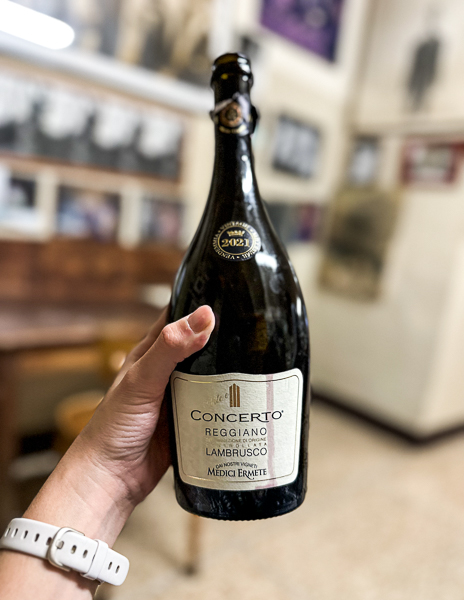
Regarding Emilia-Romagna drinks, Lambrusco is a must-try. It’s the region’s sparkling red wine from grapes in the Emilia-Romagna countryside. There are three types of Lambrusco: sweet, semi-sweet, and dry.
Like regular non-sparkling wine, vineyards produce Lambrusco in different styles, so you’ll want to try a few. We were not impressed the first time we had Lambrusco; the taste fell flat. Then later, we were served a better quality and tasted bolder and more complex.
It’s typically served cold and goes great with gnocco fritto, salumi, and tigelle.
Share the tips & love on Pinterest:
